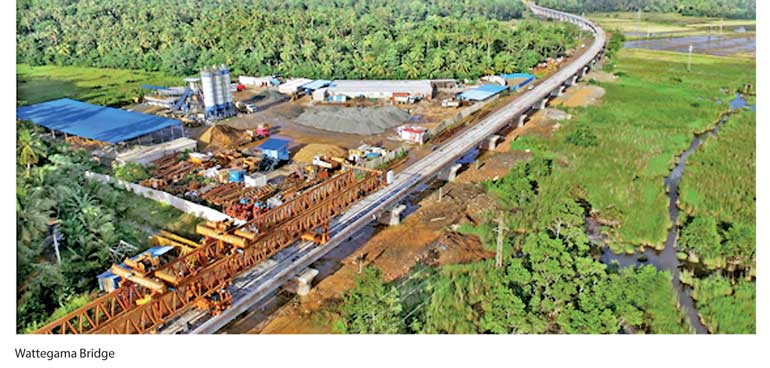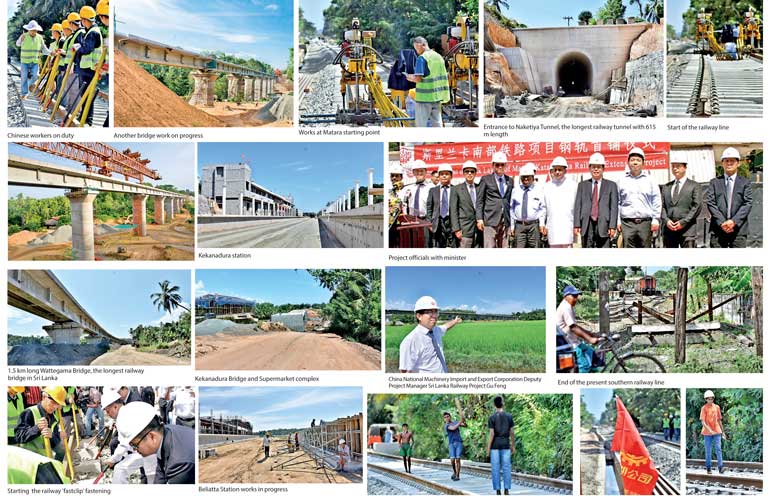Friday Mar 28, 2025
Friday Mar 28, 2025
Wednesday, 17 January 2018 00:00 - - {{hitsCtrl.values.hits}}


 By P.D. De Silva
By P.D. De Silva
A railway line beyond Matara, a dream for over a century that has got off the ground on more than one occasion is becoming a reality as State Minister for Public Enterprise Development together with many other dignitaries associated with the project tightened the stays on the first length of track laid by China National Machinery Import & Export Corporation (CMC) last week.
Among the dignitaries who attended the ceremony were Zhao Jun Vice President of CMC, Eng. G.D.A. Piyathilake Chairman of the Central Engineering Consultancy Bureau (CECB) who are the project consultants on behalf of the Ministry of Transport (MOT), Cao Lianghua of the China Railway No 5 Group (CR5G), Zhang Yongkang China Railway Electrification Company (CREC), Fu Zhigen China Railway 5th Survey & Design Institute Group, He Peizhi CMC’s Project Manager for the Southern Railway Extension Project and other Chinese and local officials.
‘The dream of a railway extension beyond Matara has a history of more than a century’ states researcher and author Dhanesh Wisumperuma in his blog ‘Diary and writings of Dhanesh Wisumperuma’. According to him research based on available documents it was in 1894 a year before the Galle to Matara railway was opened that the Auditor General of the Colonial Government James A. Swettenham had mentioned the need of extending the line beyond Matara.
The project to construct a railway line beyond Matara first got off the ground on 27 December 1991 with Minister of Transport Wijepala Mendis laying the foundation stone and cutting the first sod of earth.
A brief history of the Matara Kataragama extension in chronological order according to Dhanesh Wisumperuma is as follows:
1894 November Survey of Matara Gandara Extension ordered
1895 April ‘Gandara Railway Report’ submitted with stations at Dondra and Gandara
(5 miles and 52.7 chains at Rs. 130,811.62 per mile)
1895 December Galle – Matara Railway opened
1921 November Survey of Matara Hambanthota carried out
1923 Hambantota Railway Report submitted with stations at Kumbalgama, Walasgala, Beliatta, Polommaruwa, Ranna, Ambalantota and Hambantota and two halting places at Ratmale and Hungama. (49 miles and 56 chains at a maximum of Rs 160,459.23 a mile)
1990 Government of Sri Lanka approves construction of Matara – Kataragama Railway Extension
1991 27 December Foundation laid and first sod cut by Wijepala Mendis (Minister of Transport)
1993 June Environmental Assessment submitted
2001 Piladuwa substation and 2km track opened by Dinesh Gunawardena (Minister of Transport and Environment). The track was used on a few occasions but later abandoned.
2006 25 March Foundation stone for Nilwala Railway Bridge laid by President Mahinda
Rajapaksa (the bridge was completed in 2008)
Every time the southern railway extension project got off the ground it could not be completed due to lack of funds until the Chinese Government agreed to fund it. On 31 October 2013 the construction of Phase I of the Matara – Beliatta section of the proposed Matara – Kataragma Railway Extension with stations at Kekanadura, Bambarenda, Wewurukannala and Beliatta and two sub-stations at Piladuwa and Weharahena was awarded to hand over to China National Machinery Import and Export Corporation a Chinese government entity. The project costing $ 278.2 million was funded by China Exim Bank.
“President Maithripala Sirisena is keen on commencing phase II of the southern railway extension once the Matara – Beliatta railway line is operative,” said Minister of Public Enterprise Development Lakshman Yapa Abeywardena at the ceremony held to lay the railway track beyond the Matara station last Friday. Phase I the 26.75 kilometre Matara Beliatta railway extension comprises of four stations and two substations covering a total floor area of 24,000 square meters, 66 culverts, 12 bridges totalling 3,789 meters in length, two tunnels totalling 882 meters in length and 3.4 million cubic meters of earthwork. The 615 meter long Nakuttiyagama tunnel will be the longest railway tunnel in the island while the 1.5 kilometre long Wattegama Bridge will be the longest railway bridge as much as the 15 meter tall Weralagoda Bridge will be the tallest railway bridge. Phase two of the southern railway extension is from Beliatta to Hambanthota a distance of 48 kilometres.
“We are privileged to be associated with the southern railway extension project as its consultants,” said Eng. G.D.A. Piyathilake, Chairman of the Central Engineering Consultancy Bureau. “The CECB will cooperate with the main contractor to complete phase one within this year. The southern railway extension will be a land mark project when it becomes operative,” he added.
“I wish to express our deep appreciation to Lakshman Yapa Abeywardena present here today and Minister of Transport and Civil Aviation Nimal Siripala de Silva who was unable to attend the ceremony, the representatives from the Chinese government, the Chinese Exim Bank and all of you who have supported us and are present here today,” said Vice President of CMC Zhao Jun in his address. “The southern railway extension from Matara to Kataragama is a key project for the development of Sri Lanka as it will link the new industrial zone in Hambantota and the sacred city of Kataragama. It will far reaching positives of the economy and social developments of Sri Lanka and will also consolidate the friendship the understanding corporation between the people and governments of Sri Lanka and China. I have the fullest confidence that with the support of all the stake holders the project will be completed in less than 10 months,” he added.
Pix by Indraratne Balasuriya
Discover Kapruka, the leading online shopping platform in Sri Lanka, where you can conveniently send Gifts and Flowers to your loved ones for any event including Valentine ’s Day. Explore a wide range of popular Shopping Categories on Kapruka, including Toys, Groceries, Electronics, Birthday Cakes, Fruits, Chocolates, Flower Bouquets, Clothing, Watches, Lingerie, Gift Sets and Jewellery. Also if you’re interested in selling with Kapruka, Partner Central by Kapruka is the best solution to start with. Moreover, through Kapruka Global Shop, you can also enjoy the convenience of purchasing products from renowned platforms like Amazon and eBay and have them delivered to Sri Lanka.
Discover Kapruka, the leading online shopping platform in Sri Lanka, where you can conveniently send Gifts and Flowers to your loved ones for any event including Valentine ’s Day. Explore a wide range of popular Shopping Categories on Kapruka, including Toys, Groceries, Electronics, Birthday Cakes, Fruits, Chocolates, Flower Bouquets, Clothing, Watches, Lingerie, Gift Sets and Jewellery. Also if you’re interested in selling with Kapruka, Partner Central by Kapruka is the best solution to start with. Moreover, through Kapruka Global Shop, you can also enjoy the convenience of purchasing products from renowned platforms like Amazon and eBay and have them delivered to Sri Lanka.